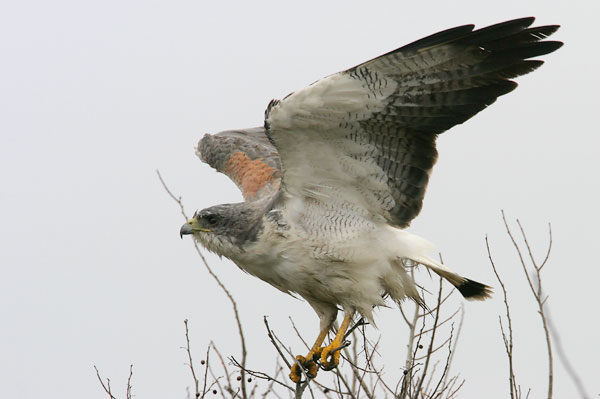White-tailed hawks (Geranoaetus albicaudatus) are birds of prey renowned for their stunning aerial acrobatics and striking appearance.
With their distinctive white tail feathers, you can easily recognize them in the sky. You can see them soaring above open grasslands and prairies in coastal and southeastern Texas, looking for their next meal.
Whether you’re a seasoned bird-watcher or just someone who appreciates the beauty of nature, these creatures are sure a wonderful sight.
On this page
Breeding Male
Male White-Tailed Hawks are stocky and large birds that grow 17-24 inches long and have a wingspan of 46-56 inches. They have slaty-gray wings, back, and heads with rust-colored patches on the shoulders. Their underbelly and underwing coverts are white whereas their primaries are dark. Their short white tail with a thick black band near the end is most distinguishable in flight. The bird has a dark beak, pale yellow feet, black talons, and hazel eyes.
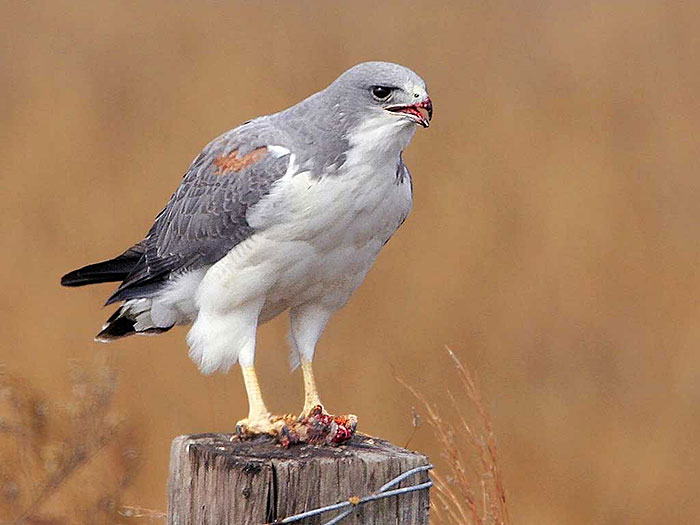
Female
Female White-Tailed Hawks look the same as their male counterparts, although it is important to note that in most hawk species the female is a bit larger and heavier than the male. Adult birds have also light and dark morphs, but they are not related to the sex of the bird.
The dark morph has dark gray underwing coverts and belly instead of white ones, although the subspecies in North America doesn’t have the dark morph.
Juvenile
Juvenile White-Tailed Hawks have a dark brown, almost black body and wings. They have a white breast patch and a faintly barred tail. Their underwing coverts are dark brownish and their primary feathers appear white with dark barring when in flight. It takes 4 years for the juvenile to get adult plumage.
Juveniles fledge in 46-55 days after hatching but stay with their parents and are fed by them for up to 7 months or more.
Habitat
You can see these birds in coastal and southeastern Texas, specifically in native coastal prairies and dry grasslands that have some trees and shrubs. White-Tailed Hawks nest at the top of low trees or shrubs 3-40 feet, on average 6-10 feet above the ground.
Nest is a bulky platform made from sticks, twigs, grasses, and weeds that is built by the pair together. Sometimes the birds bring a long stick to embellish the nest, it has no other apparent use or meaning.
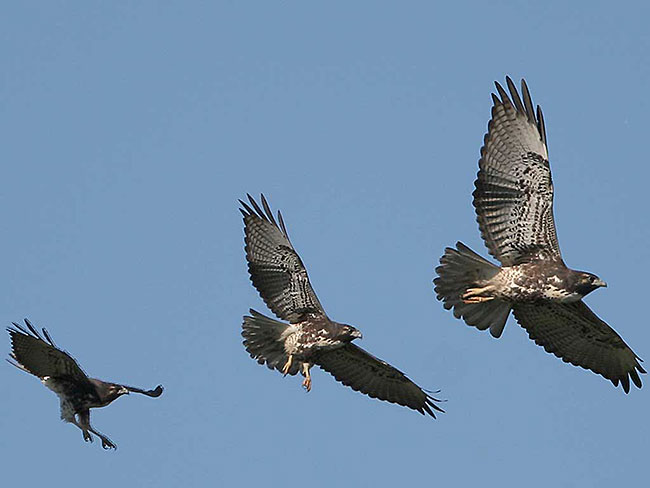
White-Tailed Hawk’s eggs are mostly white, although sometimes spotted with brown. The female lays 1-4, on average 2-3 eggs that are 2.1-2.6 inches long and 1.7-2.0 inches wide, and incubates them for 29-32 days.
Diet
White-tailed Hawks are carnivores, eating mostly mammals but also other small vertebrates and large insects. They either soar through the sky, sometimes hovering or kiting in the breeze, or observe from high perches in search of prey.
When they spot their prey, they drop onto it and pierce it with their talons. You can also see them snatching insects from midair or stealing prey from smaller species. This bird is attracted to grass fires where they prey on creatures trying to escape the flames.
Their diet is quite varied. White-Tailed Hawks eat various rodents, such as rats and mice, rabbits, birds, snakes, frogs, lizards, small fish, shrews, and different large insects. They occasionally feast on dead carcasses, although they don’t prefer it and eat it only as a last resort.
Behavior
White-Tailed Hawks are solitary birds that are most active during the day or in the mornings and evenings.
These birds form monogamous bonds for multiple nesting seasons. Their courtship display includes flying low and rising up to great heights, then returning to a perch. Sometimes these flights are directed at an intruder.
Both parents are involved in taking care of their offspring. They build their nest together; the female incubates the eggs, and the male brings the female food. Both parents feed their younglings.
White-Tailed Hawks are generally not a threat to humans unless you are in the vicinity of their nest during the breeding season, in which case they may try to chase you away.
Range (and seasonal changes)
White-Tailed Hawks range in coastal and southeastern Texas, but also in South America, Central America, and Mexico. There are three subspecies of this bird, all of which have their own range and distinguishable characteristics. They stay in their territory year-round and are not migratory.
Wing shape
White-Tailed Hawks have passive soaring wings that are noticeably broad, which they hold in a slight V-shape. It is directly related to how they fly and hunt – they soar over open fields, doing wide and lazy circles, sometimes staying in one place thanks to the breeze or hovering.
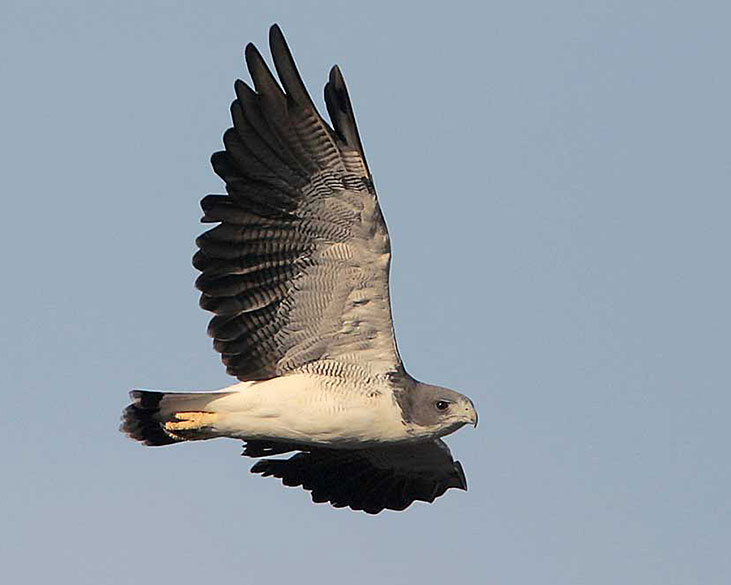
Passive soaring, noticeably broad wings, which they hold in a slight V-shape.
Fun Facts of White-Tailed Hawk
- Some species of songbirds, such as Northern Mockingbirds and Scissor-Tailed Flycatchers often nest near or even in the same tree or bush as White-Tailed Hawks. They do this because it may offer some protection from other predators.
- White-Tailed Hawks symbolize heightened spiritual awareness and the ability to see the bigger picture. Seeing one in your dreams is seen as a sign that you’re ready to make major changes in your life and pursue your own path. They can also signify that you need to pay attention to your surroundings, or that you should be aware of something.
- In many cultures, hawks are a symbol or a messenger of a god. They mostly symbolize courage, power, strength, protection, and good luck.
- Hawks can see ultraviolet light. They use this to track their prey and follow them to their hiding place.
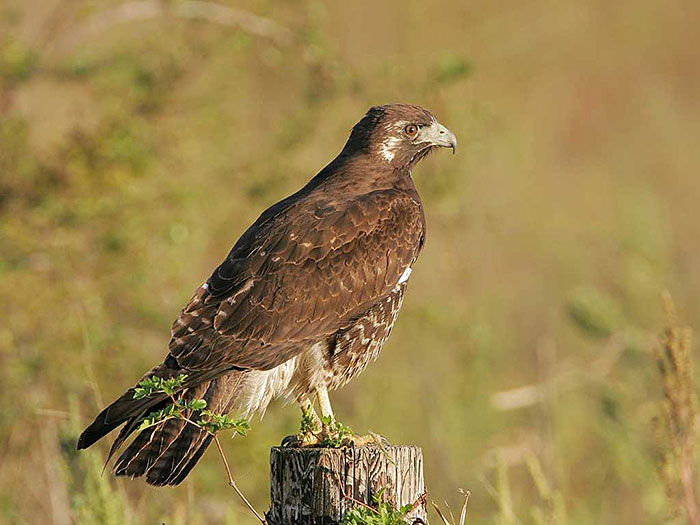
Vocalization
White-Tailed Hawk’s call is scratchy and high-pitched, beginning with a rising whine that is followed by a series of two-parted notes. It sounds similar to other hawks’ cries and may sound something like ke-ke-ke.
Juvenile White-Tailed Hawks beg for food with a nasal and whistled peeeeep that they may repeat several times.
Frequently Asked Questions
Are white-tailed hawks rare?
White-Tailed Hawks are not rare in their range, however, in the United States and North America in general, you can only meet them in coastal and southeastern Texas.
Where are white-tailed hawks found?
In North America, you can meet White-Tailed Hawks in the prairies and dry grasslands of coastal and southeastern Texas. However, you can also see them in Mexico, Central America, and a big part of South America.

